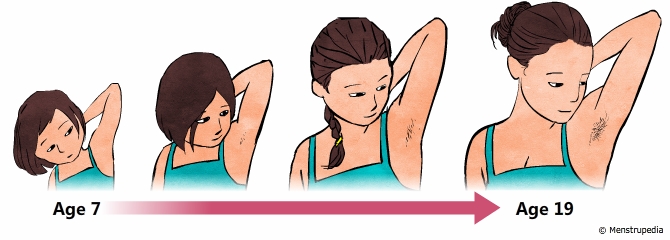Puberty – the period during which adolescents reach sexual maturity and become capable of reproduction.
As you grow from a child into an adult, your body undergoes several changes to prepare you for sexual activity and reproduction. In this article, we’ll take a closer look at some of the body changes that girls go through during this special period.
Puberty is kicked off by a hormone called gonadotropin-releasing hormone, which comes from a part of your brain known as the hypothalamus and triggers a hormonal chain reaction.
Gonadotropin-releasing hormone stimulates your pituitary gland to release follicle-stimulating and luteinizing hormones. These hormones signal your ovaries to start producing sex hormones (mainly estradiol).
All of these hormones are responsible for the various bodily and emotional changes that you go through during this time of your adolescence. For girls, puberty lasts on average from about the age of 9 to 15. At this point, you can get pregnant and give birth to a baby.
As you approach a double-digit age,you might start to notice some changes. These puberty changes are quite similar in all adolescents. However, everyone grows at a pace dictated by their own body. For example, your best friend might have fully developed breasts (known as thelarche) by the age of 13, whereas yours might not fill out until you are 16. This is a normal variation and does not necessarily mean that something is wrong.
Puberty symptoms
Here are some of the puberty symptoms experienced by girls.
Weight gain and peak growth
While the events surrounding puberty are mostly related to sexual and reproductive maturity, your whole body goes through significant changes, especially with regards to your weight and height.
You might appear more shapely than before as the fat in your body settles in new places. Typically a lot of it will be deposited around your thighs, hips, and breasts. You will also grow considerably taller during this time.
Girls tend to experience this growth spurt earlier than boys. This means that you might find yourself taller than the boys in your class when you come back to start a new school year.
Breast development
For many, the first sign of puberty in girls is the development of breasts. Around nine years old, you may notice that breast buds are developing on your chest just under your nipples. In some instances, these can be tender and sore. This is completely normal and nothing to worry about. The tenderness is a result of the new breast tissue growing and establishing itself. The breasts will finish developing around age 15, although this happens at different times for different girls.
Pubic and axillary hair
The growth of pubic hair — also known as pubarche — is one of the first signs of puberty. This first appears as light, straight, soft hairs growing in your pubic area. As you progress further into puberty, the hair gets longer, thicker, and coarser.
This patch of hair will also spread to your inner thighs, forming an upside down triangle shape. You might also notice that hair has begun to grow under your armpits as well (axillary hair).
Periods and vaginal discharge
Around two years after the start of your puberty, you might notice some vaginal discharge or even blood in your underwear. This is usually your first period — menarche.
This is the point where the follicle-stimulating and luteinizing hormones are having a regular effect on your ovaries. You are able to ovulate (when your ovary releases an egg). This means you are able to get pregnant. If there is no sperm to fertilize the egg, you get your period (menstruation).
Getting your first period can be scary if you don’t know what to expect. You should consider speaking to an adult you trust (at home or at school) who can answer any question you might have on what to do before and after your first period. On average, the length of time from the start of breast development to menstruation is typically 2.5 years. Again, this will vary from girl to girl.
Acne and breakouts
During puberty, hormones cause your sweat and oil secreting glands to become more active. Your skin might break out as your pores become clogged with excess oil (sebum). The most common places for acne to appear are on your face, back, and sometimes chest.
Acne affects everyone in their pubescent years. Girls might notice periodic breakouts because of cyclic spikes in their sex hormones.
Voice change
During puberty, your voice is also likely to change. This is because the sex hormones mentioned earlier have an effect on your voice-producing mechanism. Estrogen and progesterone cause your voice to lower a bit. The typical female voice is one third lower in frequency than a child’s voice.
Again, we are all different, so if your voice still sounds the same or even gets deeper, that doesn’t make you abnormal.
For many girls, puberty usually ends around age 15, when all the secondary sex characteristics have developed. At this age, your breasts have probably filled out, although they might continue to increase in size throughout your teens. Your pubic hair has finished growing in, appearing on the inner thighs as well as the lips of your vagina. Your vagina and reproductive organs are fully developed at this stage, and your hips and thighs may also have filled out.
This may not be the case for every girl. If you do not notice any of these changes by the age of 14, it may be a good idea to see a doctor to be sure that everything is in order.








